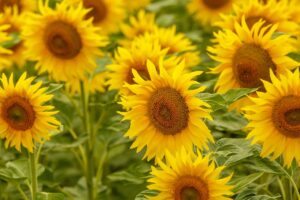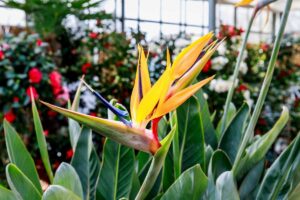With their elegant flowers, orchids make enchanting houseplants.
And since proper hydration is a must in order to keep them healthy and to encourage blooming, you might be wondering how and when to water them.
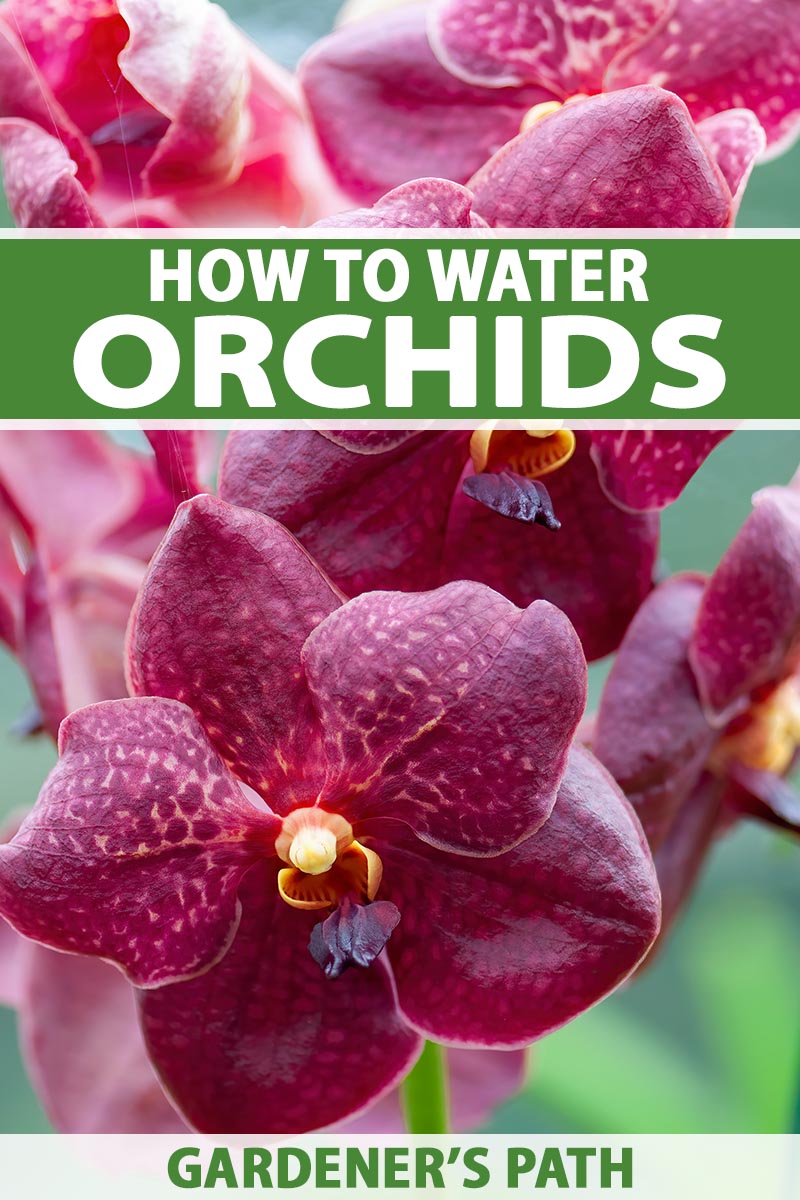
We link to vendors to help you find relevant products. If you buy from one of our links, we may earn a commission.
The answer depends on a few different factors, such as the growing medium, container type, time of year, and – above all – the type of orchid.
But even if you don’t know what type you have, there are other ways to discern these plants’ hydration needs.
In this article we’re going to discuss when these plants need to be irrigated and typical requirements for different types.
And in case you don’t know what type you have, we’ll look at various factors affecting hydration needs so you can read and interpret the signs that are available to you, and understand your houseplant.
Finally, we’ll look into some best practices and answer some of the questions you might have, such as that recurring query as to whether orchids really can be watered with ice cubes or not.
Ready to get started? Here’s everything we’ll go over up ahead:
What You’ll Learn
When to Water an Orchid
Rather than offering it a drink every time you have an unfinished glass of H2O to dispose of, you will want to wait to hydrate your orchid until it needs moisture.
Sounds like a perfectly logical statement, right? But I know you’re wondering, when does it need to be watered?
This will vary from type to type, and we’ll cover that in more detail later in the article. First, let’s talk about some generalities that can be helpful.
Most orchids grown as houseplants are epiphytes or lithophytes that evolved with their roots growing fairly exposed on trees or rocks. As such, orchid roots require well-aerated conditions, not soggy ones.
In general, these species like humid air but not wet feet. That means you will increase the risk of root rot if you irrigate too often.

A good place to start with most houseplant orchids, which are usually Phalaenopsis hybrids (also called “phals”), is to water once a week.
This is only an estimated guideline since you will need to take other factors into account as well.
For instance, depending on the conditions in your home in summer, irrigating might need to happen more often, and less often in winter.
Other types of orchids may need different treatments throughout the year. We’ll discuss this more thoroughly a little later in the article, so keep reading!
Signs of a Thirsty Plant
Now that you know why it’s important not to go around dumping water into your plant’s pot willy-nilly, we’re going to get into some specifics that should help you feel more confident about your specimen’s hydration needs.
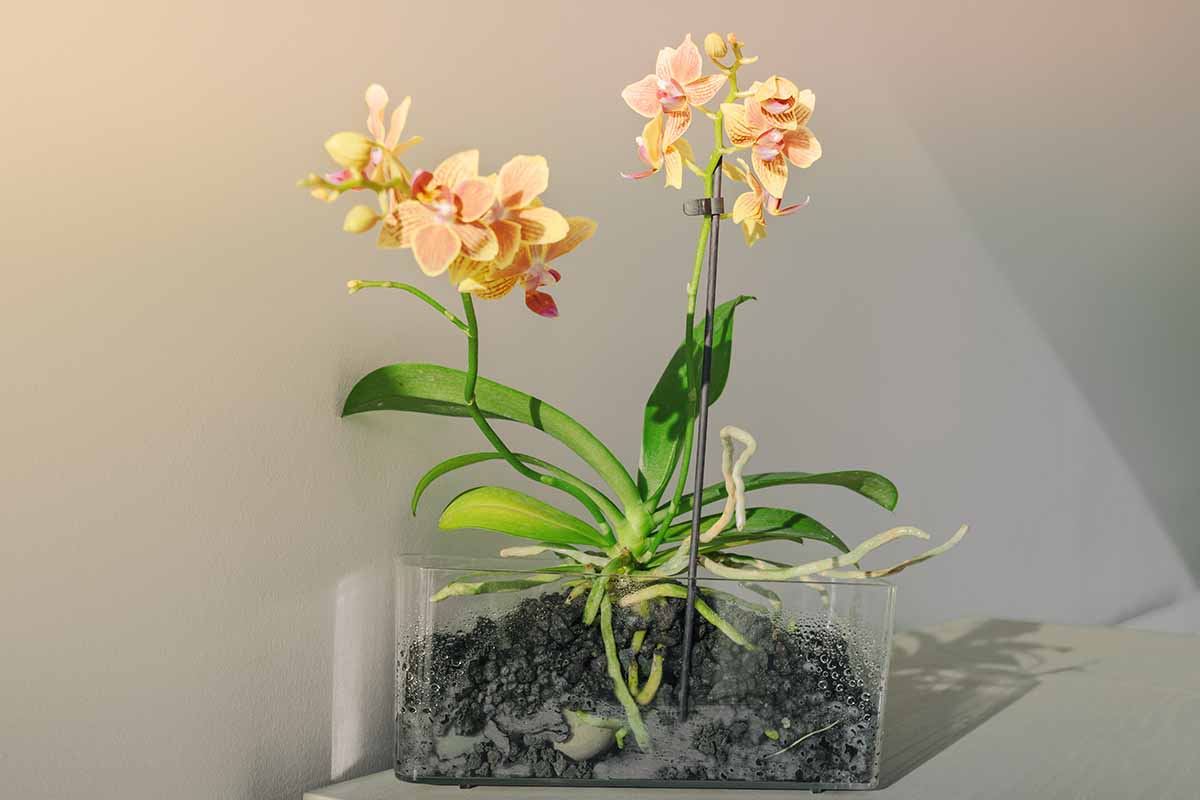
One of the most important habits you should get into when developing an irrigation routine for your houseplant is to lift its pot when it has been freshly hydrated, and again when it’s dry.
Keep these weight differences in mind so that you know by feel how light the plant is when the potting medium is dry.
Growing mediums will also be darker when they are wet, so you can also use this as a reference when checking your houseplant as well.
And if your specimen is growing in a transparent pot, you can check it for condensation. If the moisture content is still high, you will notice droplets on the inside of the plastic pot.
If you’re wondering if using a moisture meter is a good way to judge the hydration of these plants, I’d like to stop you right there.
According to William Cullina, author of “Understanding Orchids,” available via Amazon, these tools aren’t calibrated to work with typical orchid growing mediums.

But there are other options. Since meters aren’t a reliable way to measure the moisture content of the potting medium, you can insert a pencil into the growing medium and see if any moist particles come out, stuck to the pencil. Or you can insert your finger and see if it feels wet.
The caveat here is that mediums can dry more slowly at the center and bottom of the pot than they do on the surface. If you have a specimen that needs to dry out entirely between drinks, you’ll need to check the moisture in the bottom of the pot as well.
Now that you have some tips for judging how wet or dry the plant’s growing medium is, there are also a few signs in the plants themselves that you can look for to recognize dehydration.
Phalaenopsis plants don’t usually show signs of wilting unless things get pretty bad.
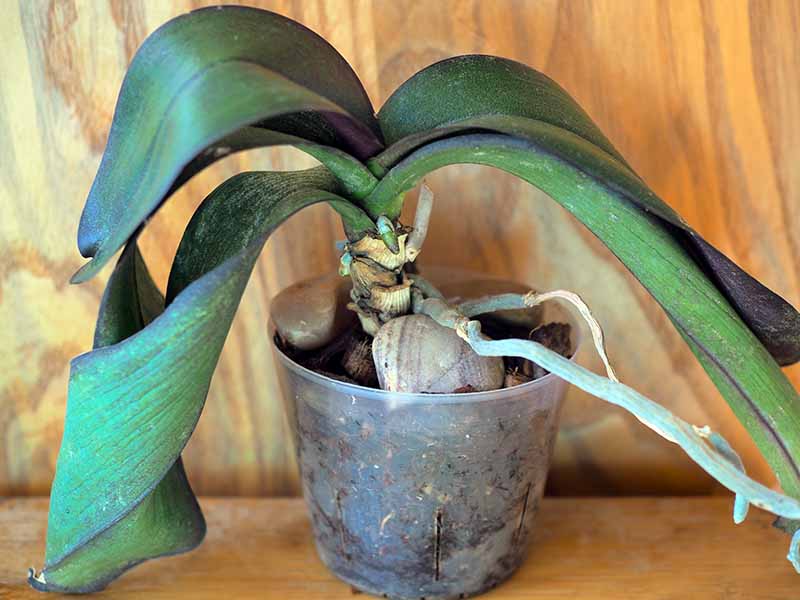
Healthy specimens have thick, leathery foliage that is held out more or less horizontally. A very dehydrated phal will have leaves that are limp and drooping.
You shouldn’t wait to irrigate a phalaenopsis until you notice limp leaves – but if you do observe this sign in your houseplant, know that you have waited too long!
Unlike phals, some other types of orchids have pseudobulbs, water storage organs that help to keep plants hydrated during periods of reduced moisture.
These pseudobulbs will start to shrivel when the plant is getting dehydrated, while a well-hydrated plant will usually have nice, plump pseudobulbs.
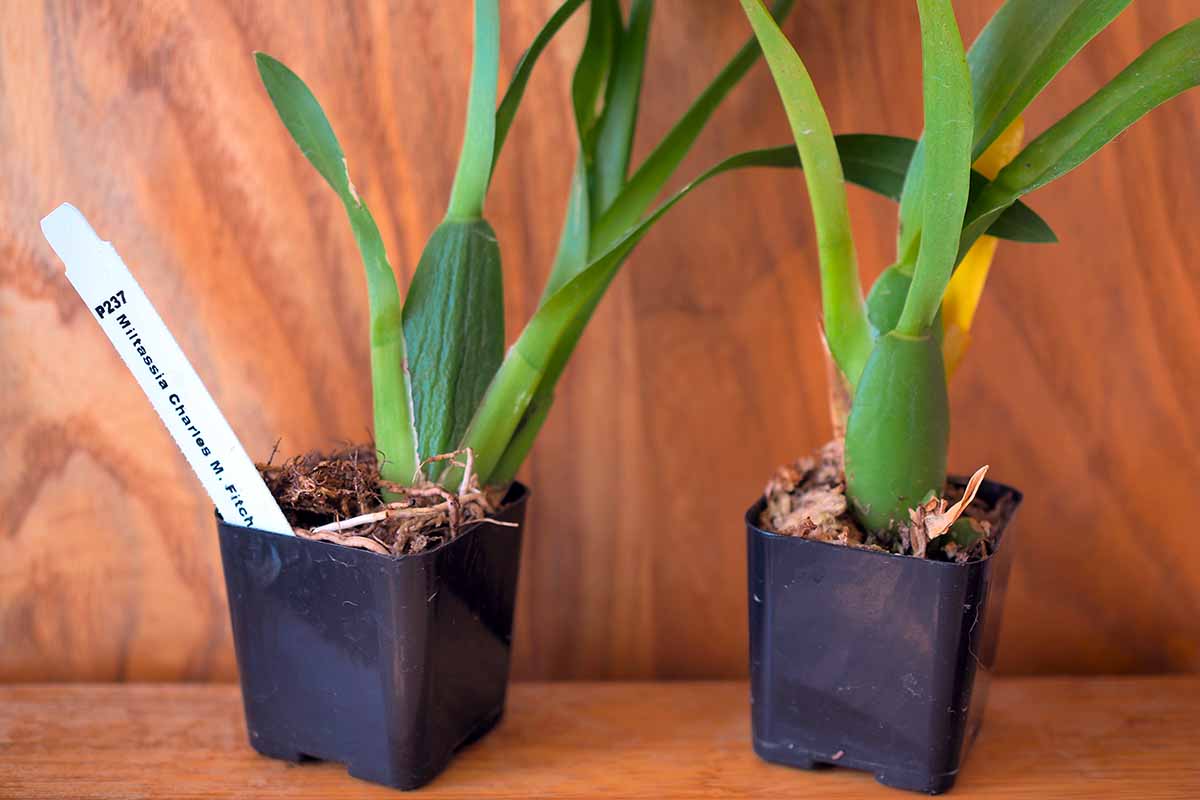
There are some exceptions to this rule – some species have somewhat shriveled-looking pseudobulbs even when they’re well-hydrated. Get to know your plant to understand what is normal for it.
Another “sign” you can use to hydrate your houseplant on a timely basis is the record you create by keeping track of irrigation in a garden journal.
This won’t tell you exactly when your plant needs to be watered, but it will help you to keep a rough idea in mind.
Some plants tend to do well with a weekly drink, others may need one more or less often. If you note each visit with the watering can, you’ll be at least that much more aware of your plant’s hydration cycles and needs.
Water Requirements for Different Types
We’ve seen that phalaenopsis orchids can be irrigated more or less once a week when kept as houseplants.
But there are many, many other types, some which need irrigating more frequently, and some less. So if you aren’t sure what type you have, it’s a good idea to find out!
If you need help identifying your houseplant, be sure to check our article on 23 different types of orchids.

Here are some guidelines for these and some of the other most popular orchids kept as houseplants.
Some prefer to dry out almost completely between drinks, such as phalaenopsis, cattleyas, and miltonias.
Cymbidiums and oncidiums should be irrigated when the top inch or two of the growing medium is dry.
Some orchids, like moisture-loving paphiopedilums and ludisias, also known as jewel orchids, should be irrigated when the surface of the soil is just dry to the touch.

If you are growing phragmipediums, just like carnivorous plants, these species require damp conditions and should be kept moist.
Some orchids are cultivated in such airy growing mediums that they need to be irrigated quite frequently, up to several times a day during hot weather, such as members of the Vanda genus.
Factors Affecting Water Needs
You should now have an idea of the drastically different hydration needs of different types of orchids.
However, if you received one of these plants as a gift or inherited it, you still may not know what type you have exactly.
Fortunately, there are other ways to decipher its needs. We’re going to look at those next.
Water Storage Organs
Some of these plants have built-in ways of storing moisture, referred to as “water storage organs.”
Such features allow these species to resist dry periods better. Recognizing them in your houseplant will allow you to understand how drought-proof your specimen is – or is not.
If your specimen has pseudobulbs or thick, leathery leaves it will be at least somewhat adapted to low moisture conditions, and should be able to recover more easily from having a dry growing medium.

However, if the plant has no pseudobulbs, or if it does have pseudobulbs but it also has thin leaves, be more careful not to stretch intervals between irrigation too long.
Also, some species are able to store moisture in their thick, fleshy roots, while those with thinner roots are more susceptible to drought conditions.
Be more vigilant about keeping those specimens hydrated that lack these adaptations to store moisture.
These plants evolved in habitats where moisture was plentiful year round, and may not be able to survive if they’re allowed to dry out.
Time of Year
Most orchids will require at least slightly less moisture during the winter, simply because cooler winter conditions and shorter days mean they use up water more slowly.
However, some species require even greater reductions in moisture during winter, with extreme examples being those that are deciduous and shouldn’t be watered at all.
Some varieties that need reduced moisture during the winter include cattleyas, and some types of oncidiums and epidendrums.
On the other hand, plants such as jewel orchids, paphiopedilums, phalaenopsis, and phragmipediums haven’t adapted to require a dry rest period during the winter, and should be watered similarly throughout the entire year.
Likewise, as temperatures rise during the summer months, most specimens will require more moisture.
There is of course an exception to this – if you keep your home at a steady temperature year round, your houseplants may not exhibit as much of a change in how much they drink from season to season.
Type of Container
In addition to climatic conditions, there are a couple of other factors which will influence your houseplant’s hydration needs.
Plants growing in plastic or glazed ceramic pots will retain moisture longer than those in unglazed clay pots.
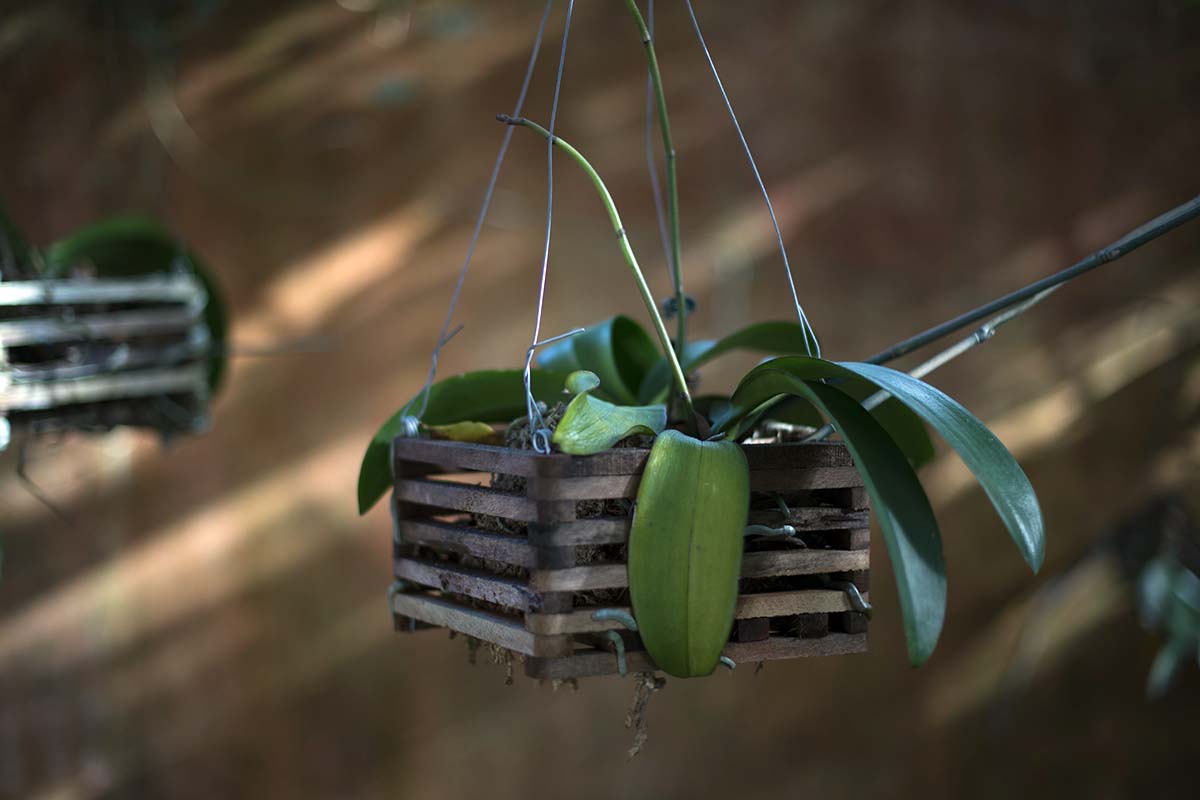
Some orchids are grown in slatted baskets, which helps to keep their roots aerated, but this also means they will need more frequent irrigation.
And on the extreme end of the spectrum, mounted specimens can have the highest moisture needs, with some requiring irrigation a few times a day during periods of warm weather.
Type of Growing Medium
The type of growing medium the specimen is cultivated in will also influence how quickly it dries out.
For instance, many phals are sold potted in moss – this is a highly retentive medium which can become overly soggy. Phalaenopsis houseplants growing in moss may only need to be watered every two to three weeks on average.
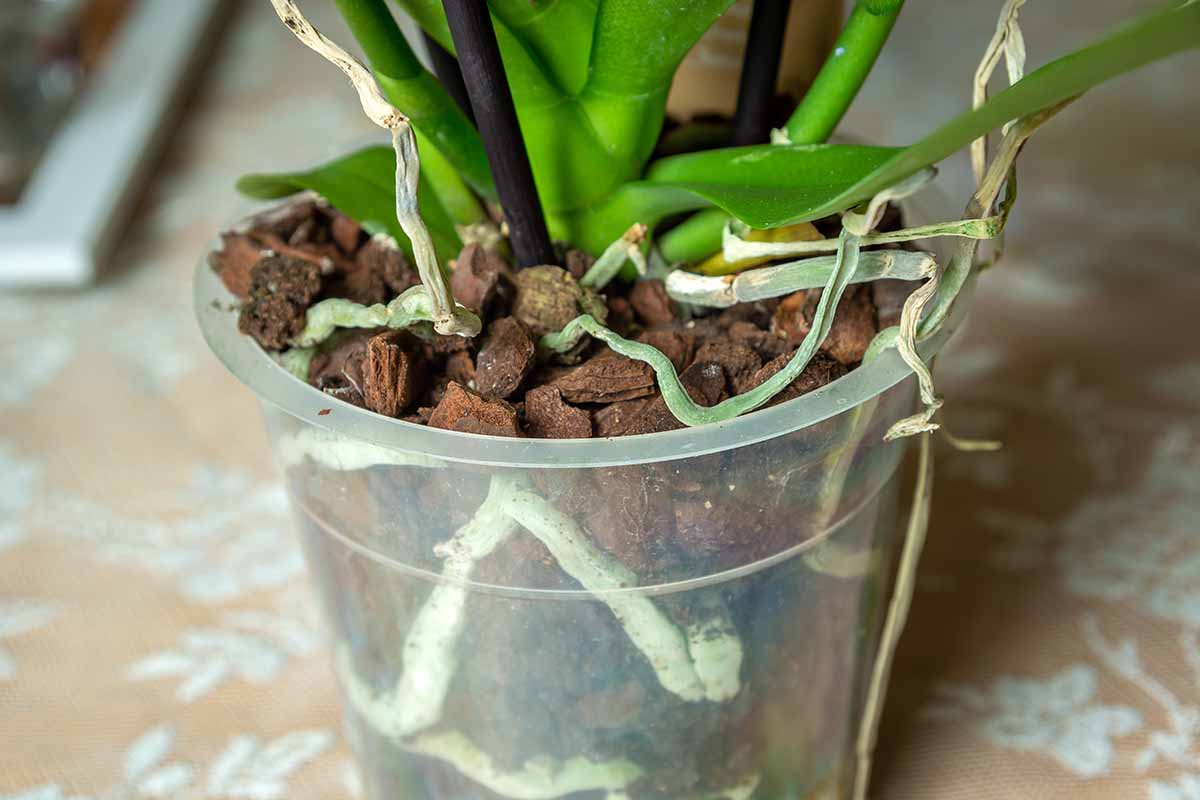
On the other hand, bark allows for faster drainage and reduces the risk of soggy conditions, but specimens cultivated in this medium will require more frequent irrigation than those grown in moss.
And there are other combinations of growing mediums for members of the Orchidaceae family as well, including clay balls and charcoal. Some orchidophiles even grow them in Styrofoam peanuts!
In short, if a plant is cultivated in a highly moisture-retentive growing medium, it will need to be watered less often, while those cultivated in fast-draining mediums will dry out more quickly and need more frequent irrigation.
Best Orchid Watering Techniques
Now that you understand what type of orchid you might have, and whether it is likely to dry out quickly between waterings or not, let’s look at some of the techniques you might consider.
Should Orchids Be Watered with Ice?
You may have seen some recommendations to simply place a few cubes of ice on the surface of your plant in lieu of liquid irrigation.
I’m going to strongly advise against this method.
First of all, most Orchidaceae plants we are likely to keep as houseplants originate in subtropical or tropical regions. So they would rarely, if ever, be hydrated with cold – much less icy – water.
A writer for the Oregon Orchid Society explains that placing ice on these plants can damage their cells and end up causing infections.
No one wants a diseased orchid, so steer clear of this method.
What Type of Water to Use
Instead of ice cubes, use tepid water to irrigate these houseplants.
Also, some plants are much more sensitive to impurities in water, such as those found in tap water.
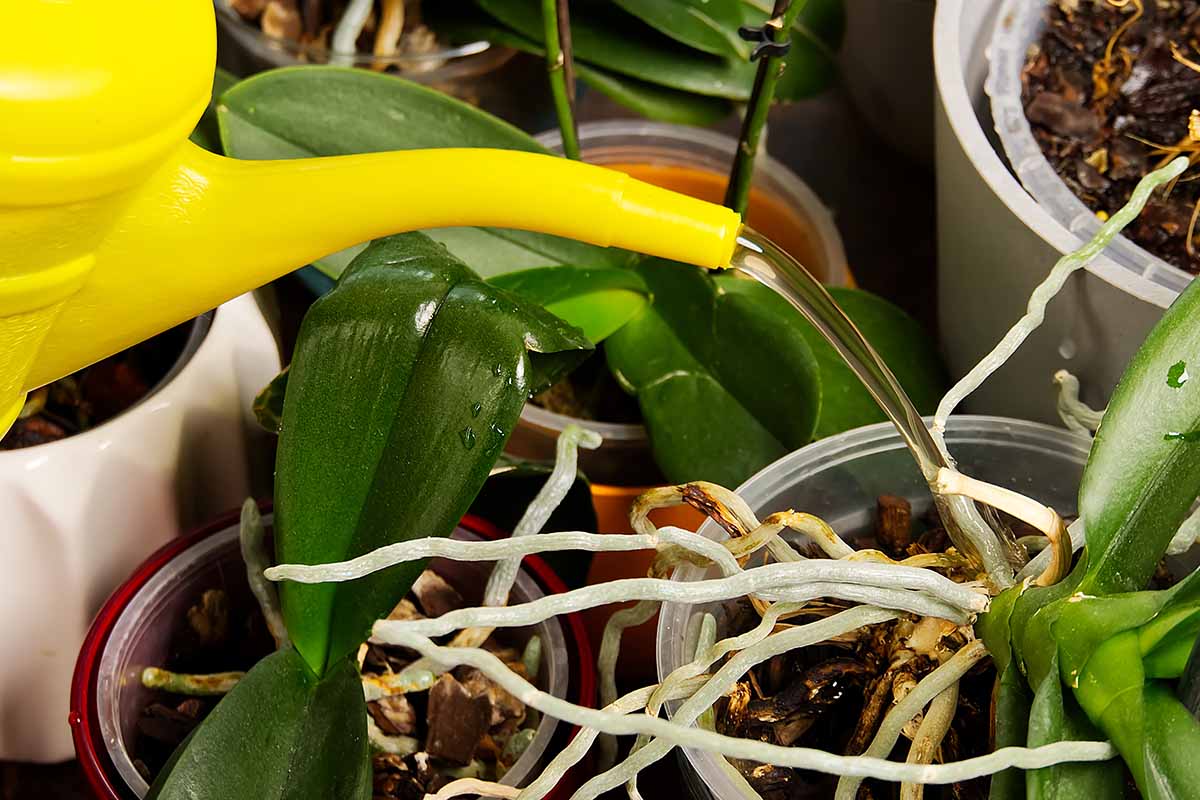
So offer these houseplants the best type of water you can – this may be filtered from the tap, rainwater, or melted snow, depending on your options.
Surface and Bottom Watering
You may also wonder whether you should irrigate from the top of the plant or the bottom. There are benefits to both approaches.
First, let me clarify – you don’t generally want to irrigate by showering the entire plant. This type of irrigation can allow species like phals to collect too much moisture in their crowns, leading to rot.

Instead, pour water over the surface of the specimen’s growing medium.
On the other hand, bottom watering by allowing these houseplants to soak in a filled basin or bowl for fifteen minutes or so can help to hydrate their growing mediums well.
However, this method can lead to a buildup of fertilizer salts. At least once a month, flush this buildup out by pouring water directly over the growing medium and allowing it to drain away.
Beware of Saucers
And no, I’m not talking about the flying type. If your houseplant has a saucer under its pot wherever it lives in your home, make sure to empty the saucer as part of your regular irrigation chores.
This goes for cachepots without drainage holes as well.
Even plant parents with excellent intentions, armed with the best caretaking knowledge, are apt to forget about a liquid-filled saucer once in a blue moon.

It may not seem like root rot could strike so quickly, but sometimes all it takes is forgetting about a full saucer for a couple of days just one time, and it’s bye-bye beautiful plant.
What I like to do to prevent myself from this type of forgetful mistake is to irrigate my houseplants by removing them from the pot covers and saucers, and irrigate them using three large bowls.
Once I have irrigated one specimen in the first bowl, I move it to the next, empty bowl, and let it drain for a few minutes.
Finally I move it to the third bowl and let it drain again. Then I can safely return the houseplant to its regular location without worrying about death by saucer.
If you only have a few houseplants, you could easily get by with one bowl for this operation – just allow the specimen to drain into the bowl, empty the bowl, allow it to drain again, and repeat if needed.
The ‘Chids Are Alright
We’ve covered a lot of information in this article so let’s do a quick review, shall we?
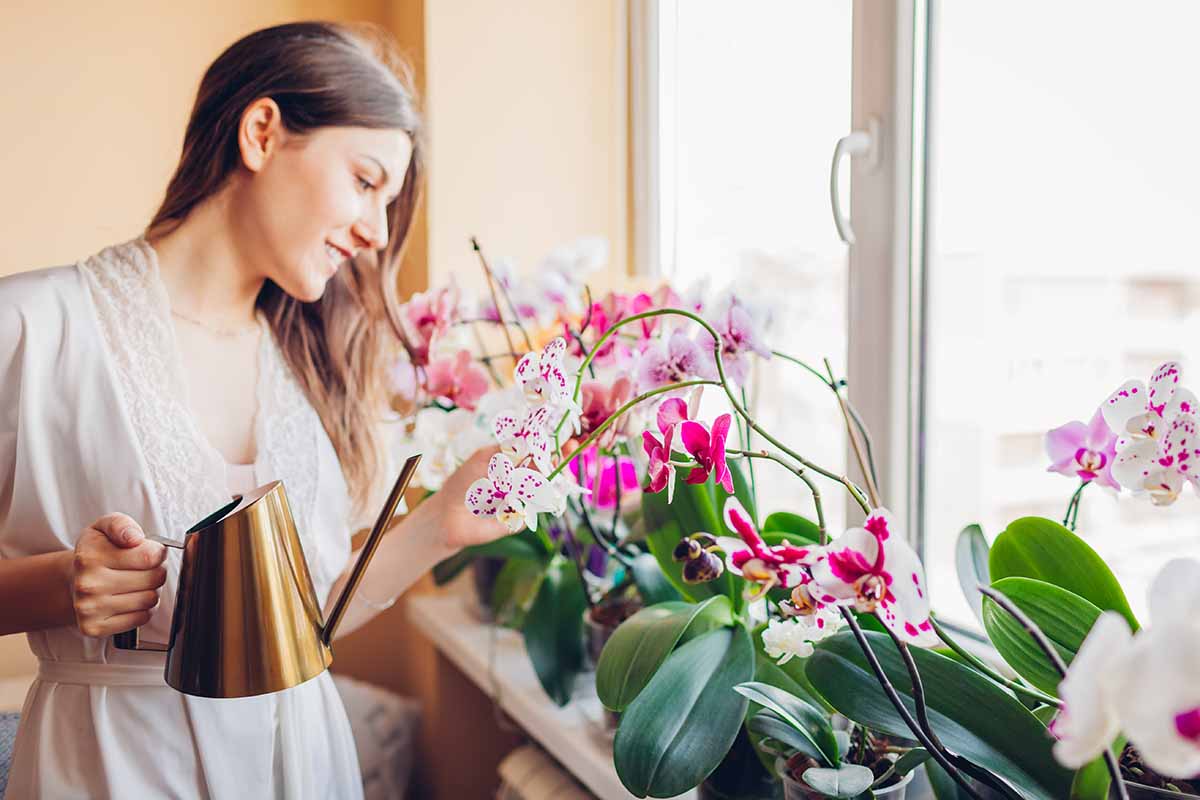
If you have a phalaenopsis, your routine is pretty straightforward – give it a drink approximately once a week, but don’t forget to factor in how cool or warm your home is.
For other types of orchids, do the research to determine the particular needs of your species or hybrid so you can proceed accordingly, and allow it to dry out only as needed.
If you have no clue what type you are caring for, look for those signs mentioned above – the presence or absence of water storage organs, wilting leaves, or shriveled pseudobulbs.
And don’t forget to take into account container type, growing medium, and time of year – and beware the dreaded unemptied saucer!
Armed with this knowledge, you should be able to care for your darling houseplant and keep it feeling fine and dandy.
Have any questions or tips of your own about hydrating these gorgeous plants? Let us know in the comments section below.
And once your houseplant chores are done, come back! We have more orchid essentials for you right here:

